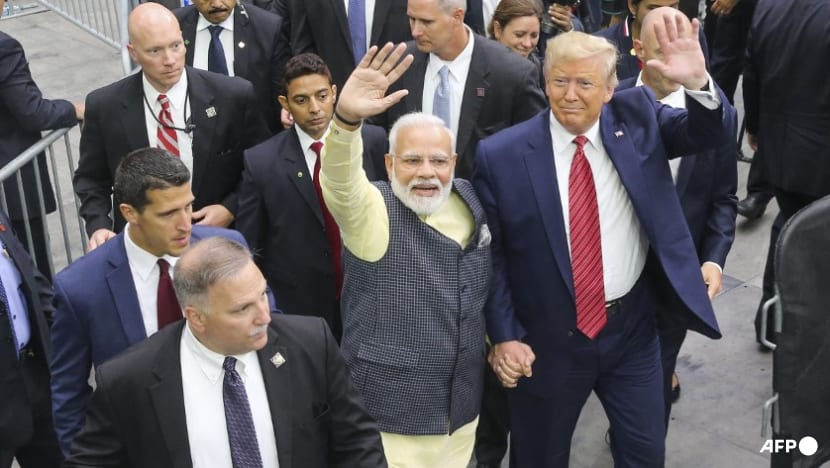Commentary: The Modi-Trump bromance has reached its limits
Indian Prime Minister Narendra Modi and US President Donald Trump once paraded a close alliance in packed stadiums. Their bromance is now under strain, says former foreign correspondent Nirmal Ghosh.

India Prime Minister Narendra Modi and US President Donald Trump walk holding hands after speaking at NRG Stadium in Houston, Texas, Sep 22, 2019. (Photo: AFP/Thomas Shea)

This audio is generated by an AI tool.
SINGAPORE: In 2019 and 2020, Indian Prime Minister Narendra Modi and then-US President Donald Trump took the stage together in front of roaring rallies in packed stadiums in their respective countries, holding hands and seemingly best friends forever.
The “Howdy Modi” rally in Houston attracted over 50,000 attendees, and the “Namaste Trump” event in Ahmedabad drew more than 100,000.
But that was during Mr Trump’s first term as president.
Now deep into his second term, Mr Trump is more emboldened in the exercise of raw transactional power. And the US’ rosy relationship with India, once touted as the strategic partnership of our time, has abruptly hit the rocks.
The unravelling is not to be underestimated; it combines a clash of both geopolitical and domestic interests that will be hard to reconcile, and endangers decades of painstaking diplomatic work.
“I AM READY TO PAY THE HEAVY PRICE”: MODI
The first signs of strain in their bromance were already visible during Mr Modi’s visit to the US in February.
Although Mr Trump said he was thrilled to welcome “his friend” Mr Modi back to the White House, he did not hesitate to publicly rebuke India’s "unfair, very strong tariffs", calling them a "big problem".
After months of negotiations, by July a trade deal was supposedly ready. Instead, Mr Trump slapped a 25 per cent tariff on Indian goods – and then an additional 25 per cent as punishment for New Delhi's continued purchase of Russian oil.
The sticking point was not just Russian oil – which may not have been as big an issue if Mr Trump had succeeded in getting Russia and Ukraine to agree to a ceasefire deal he had promised his base. It was India’s reluctance to allow market access for American agricultural and dairy produce.
It is a fact that India needs internal market reforms; even as the economy grows at over 6 per cent, unemployment and underemployment remain chronic. Yet opening up agriculture and dairy to foreign competition would be untenable politically. Mr Modi faces a legislative election in Bihar, a largely agricultural state, in November.
India will never compromise on the interests of farmers, fishermen and dairy farmers, said Mr Modi last week. “I know personally, I will have to pay a heavy price for it, but I am ready for it.”
As India celebrates its 79th year of Independence on Friday (Aug 15), many in the strategic community in New Delhi are rethinking the country’s equation with the US following the tariffs, plus the notoriously mercurial president’s recent jibe about India’s “dead” economy.
Likewise in Washington DC, hardline America First ideologues with a binary view of the rest of the world that leaves little latitude for empathy are uncomfortable with precisely the strategic autonomy that India has been pursuing, in the shape of continued ties with Iran and, more importantly in this case, Russia.
Mr Trump also insists he was instrumental in stopping the limited but intense clashes in May between India and Pakistan – a claim India denies. Mr Trump followed up with a two-hour private lunch with Pakistan’s military chief Asim Munir at the White House. These events have left a sour taste in New Delhi and inflamed nationalistic public sentiment in India.
Mr Munir returned to the US last week to attend a black-tie dinner for the retirement of General Michael Kurilla, the commander of US military forces in the Middle East. There, he spoke of a new dimension in US-Pakistan relations, and almost casually warned of nuclear war.
HARDENING POSITIONS ON BOTH SIDES
Certainly, the US-India relationship has historically not been entirely rosy, even though there is some fundamental ideological convergence; India and the US are both liberal democracies in recent years trending towards the illiberal.
The US security establishment has long danced with Pakistan, in part to try to balance China’s influence in that country. This has historically rankled India.
Additionally, Mr Trump sees the growing BRICS group as a threat especially to the hegemony of the US dollar. He also seems fixated on cementing a legacy with the Nobel Peace Prize; for good or bad, it is not possible to separate the personal from the political in the case of Mr Trump.
The India-Pakistan episode, with New Delhi cold to his ceasefire claims, may have left a sour taste for him as well.
Meanwhile, domestic politics are hardening positions on both sides. Mr Trump was voted to power for a second time by a base that wants to revert to what it widely sees as core American values – white, conservative, patriarchal, Christian – and the country remains bitterly divided. Mr Modi’s base largely sees its core value as a conservative and inherently strongly patriarchal Hindu identity.
But the US-India relationship is also much more broad-based than it was during the Cold War. Shared concerns about an assertive China have helped nudge them closer.
The US-India Civil Nuclear Agreement of 2008 was a significant turning point. The four-member Quad brings together Japan, Australia, and the US with India in a loose arrangement. The annual joint naval exercise Malabar hosted by India includes US, Japanese, Indian and Australian naval forces.
Mr Trump’s unpredictability has begun to revive doubts. Old contentious issues - Pakistan, trade and Indian protectionist tariffs with one eye on its vulnerable farmers, and of course Russia - are back on the table, wrapped in the heightened rhetoric of nationalism.
In this new environment, some storms even if they pass can be imprinted in public memory.
In India in particular, doubt and distrust of the US will linger in the public mind even when Mr Trump is no longer in office. That means the US, while valued as a hedge against China, may go back to being at arm’s length, at least publicly, even as strategic security and military cooperation will quietly continue.
TOUCHY RELATIONSHIPS
In a recent essay in Foreign Affairs, Carnegie Endowment for International Peace scholar and former US official Ashley J Tellis - one of the architects of the 2008 civil nuclear cooperation agreement - argued that instead of pushing for “multipolarity”, Indian leaders should align more closely with the US given that, among other things, India can only hope to fend off China with American backing.
It is a compelling argument and has triggered much debate in New Delhi and Washington DC. There is a counterargument, however - that India's geopolitical environment is complex, volatile and not easily understood by the West. With neighbours ranging from friendly to unstable to hostile, India feels it must hedge. It cannot, and will not, disengage or diminish its relationship with Russia.
And though China has backed Pakistan, India and China are also beginning to mend relations after a low point in 2020 when they clashed at Galwan on their Himalayan border. Mr Modi is due to visit Tianjin on Aug 31 for the Shanghai Cooperation Organisation (SCO) summit, where he will meet Chinese President Xi Jinping.
To be sure there are issues that could torpedo the touchy relationship – the succession of the Tibetan spiritual leader the Dalai Lama looms large – so there are likely to be limits to India-China detente. Nevertheless, Chinese state media has been playing up Mr Modi’s upcoming visit.
One may have to wait until the annual Quad summit, to be hosted by New Delhi in the last quarter of this year, to gauge whether India and the US can return to the comfort zone of the first Trump, and subsequent Joe Biden administrations. Whether Mr Trump attends will be a key indicator.
Meanwhile however, ironically for the US, recent developments reinforce precisely what India believes – that it is too big to be pushed around, and it cannot depend on the US but needs to be multi-aligned, as one pole in a multipolar world.
Nirmal Ghosh, a former foreign correspondent, is an author and independent writer based in Singapore. He writes a monthly column for CNA, published every third Friday.


















